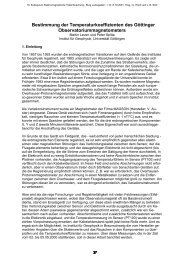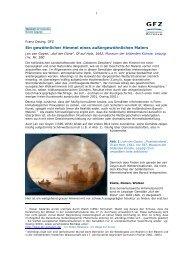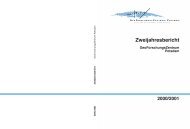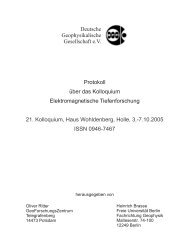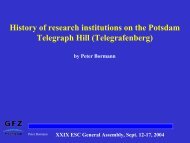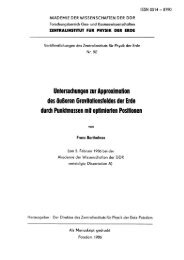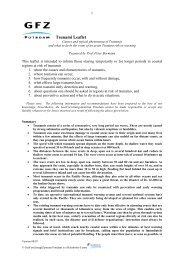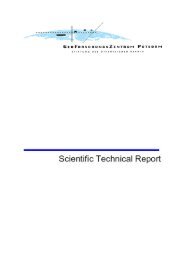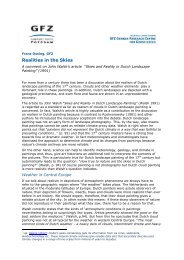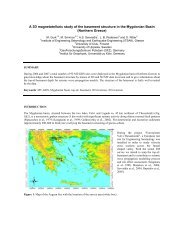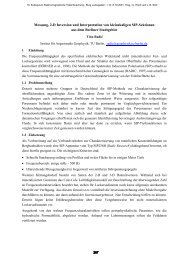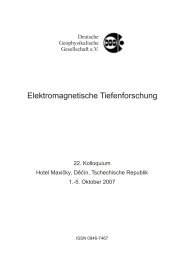Zweijahresbericht 2004/2005 - Bibliothek - GFZ
Zweijahresbericht 2004/2005 - Bibliothek - GFZ
Zweijahresbericht 2004/2005 - Bibliothek - GFZ
Sie wollen auch ein ePaper? Erhöhen Sie die Reichweite Ihrer Titel.
YUMPU macht aus Druck-PDFs automatisch weboptimierte ePaper, die Google liebt.
A comprehensive view of the Earth’s magnetic<br />
field from ground and space observations<br />
Mioara Mandea, Hermann Lühr, Monika Korte, Georgios Balasis, Hans-Joachim Linthe, Kumar Hemant, Eberhard<br />
Pulz, Patricia Ritter, Martin Rother, Claudia Stolle, Erwan Thébault, Ingo Wardinski<br />
Seit einigen Jahren gewinnen eine Reihe von Satelliten Beobachtungsdaten des Erdmagnetfelds in hoher Qualität. Das<br />
GeoForschungsZentrum Potsdam ist zum einen aktiv an dieser Art von Satellitenmissionen beteiligt und unterhält zum<br />
anderen eine wachsende Anzahl geomagnetischer Observatorien am Boden. Wir beschreiben hier die unterschiedlichen<br />
Charakteristika von Observatoriums- und Satellitendaten hinsichtlich Qualität, räumlicher Abdeckung und zeitlicher<br />
Verteilung. Es werden Beispiele präsentiert, wie aus der Kombination von an der Erdoberfläche gewonnenen Daten<br />
und Satellitenmessungen deutlich verbesserte Beschreibungen des Erdmagnetfelds gewonnen werden können. Damit<br />
eröffnen sich neue Möglichkeiten für Studien der Flüssigkeitsbewegung im Erdkern, der Leitfähigkeit des Erdmantels,<br />
der Zusammensetzung der Lithosphäre bis hin zur Dynamik von Stromsystemen in Ionosphäre und Magnetosphäre.<br />
In recent years, high-quality observations have been obtained<br />
from a number of geomagnetic satellites. GeoForschungsZentrum<br />
Potsdam (<strong>GFZ</strong>) is actively involved in<br />
these kinds of satellite missions, but is also involved in<br />
maintaining and extending ground-based geomagnetic<br />
field measurements using a number of observatories. We<br />
discuss the different characteristics of observatory and<br />
satellite data, like quality, spatial coverage and temporal<br />
distribution. Examples are presented about how the combination<br />
of ground-based data and satellite measurements<br />
can provide improved descriptions of the geomagnetic<br />
field, and how they offer new opportunities for studies ranging<br />
from core flow, mantle conductivity and lithospheric<br />
composition to the dynamics of ionospheric and magnetospheric<br />
currents.<br />
Introduction<br />
The Earth's magnetic field is mainly due to a geodynamo<br />
mechanism in the liquid, metallic outer core. The lithospheric<br />
contribution, due to rocks which acquired information<br />
about the magnetic field at the time of their solidification<br />
from the molten state, adds to the dominant core<br />
magnetic field. In addition, external fields represent a third<br />
contribution which is produced primarily by the interaction<br />
of the solar wind with the magnetosphere, and their<br />
intensities vary with the solar wind speed and the orientation<br />
of the embedded magnetic field. The solar wind<br />
modifies current systems in the magnetosphere and ionosphere<br />
surrounding the Earth, producing magnetic variations<br />
on varying time scales from a second to a solar cycle.<br />
Moreover, these highly variable external fields cause<br />
secondary, induced fields in oceans and electrically conductive<br />
regions of the lithosphere and the upper mantle.<br />
To fully describe the geomagnetic field it is necessary to<br />
either measure the intensity and two angles of direction or<br />
three orthogonal components. The angles are declination<br />
(the deviation of the local geomagnetic field lines from<br />
geographic north) and inclination (the angle of intersection<br />
with the Earth’s surface). Orthogonal components are<br />
commonly chosen to be X, Y and Z for the directions<br />
towards geographic north, east and vertically down, respectively.<br />
The unit used to describe the geomagnetic field<br />
is the nanoTesla (nT), with the Tesla in fact being the unit<br />
for magnetic flux density.<br />
When a measurement of the geomagnetic field is taken at<br />
any given point and time, the resulting value contains the<br />
superposition of fields having different origins, as discussed<br />
above and varying in magnitude. These are:<br />
1) the core field, generated in the fluid outer core, which<br />
ranges between 30000 nT at the equator to 65000 nT<br />
at the poles;<br />
2) the lithospheric field, generated by magnetized rocks,<br />
generally having a strength of the order of tens to a few<br />
hundreds of nT, but reaching a few thousand nT over<br />
strong anomalies;<br />
3) the external fields, generated by magnetospheric and<br />
ionospheric currents, and varying from fractions of a<br />
nT up to a few thousand nT during large magnetic<br />
storms;<br />
4) the electromagnetically induced field, generated by<br />
currents induced in the crust and the upper mantle by<br />
the time-varying external field, amounting up to some<br />
tens of nT.<br />
Separating these contributions directly is impossible<br />
(Mandea and Purucker, <strong>2005</strong>). In 1838 Gauss using spherical<br />
harmonic functions developed a method to describe<br />
the geomagnetic field globally, providing a rough separation<br />
between internal and external contributions to the<br />
field. Geomagnetic field models based on spherical harmonics<br />
are still widely used, but due to the multitude of<br />
sources, a strict separation of all contributions is not feasible.<br />
The geomagnetic field is also subject to temporal variations<br />
over a broad range of time scales, including complete<br />
reversals of the whole field on geological times. The<br />
so-called short-term variations are detectable over time<br />
<strong>Zweijahresbericht</strong> <strong>2004</strong>/<strong>2005</strong> GeoForschungsZentrum Potsdam<br />
63



